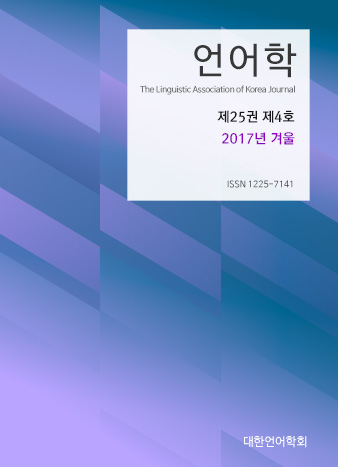대한언어학회 전자저널

25권 4호 (2017년 12월)
- Semantic Taxonomies and Tasi ‘Again’ in Korean
-
Juwon Lee
Pages : 59-81
Abstract
Lee, Juwon. (2017). Semantic taxonomies and tasi again in Korean. The Linguistic Association of Korea Journal, 25(4). 59-81. This article presents a new type of repetitive reading of the Korean adverb tasi 'again', and shows that the previous lexical or structural accounts of again cannot explain the new readings. As a solution to this problem, I propose two lexical entries of tasi 'again', the hypernymic tasi and the antonymic tasi, and argue that both entries can derive the repetitive readings (including the new readings) and restitutive readings, respectively. This account of the semantic phenomena shows an interaction between a semantic taxonomy and the lexical meaning of the adverb in Korean. Finally, I briefly discuss some similar data in English which suggest that a semantic taxonomy-based analysis is also needed for again in this language.
Keywords
# repetitive reading # pseudo-repetitive reading # restitutive reading # tasi # again # semantic taxonomy # caused change-of-state verb
References
- Beavers, J., & Koontz-Garboden, A. (2012). Manner and result in the roots of verbal meaning. Linguistic Inquiry, 43(3), 331-369.
- Beck, S., & Johnson, K. (2004). Double objects again. Linguistic Inquiry, 35, 97-124.
- Beck, S., & Gergel, R. (2015). The diachronic semantics of English again. Natural Language Semantics, 23, 157-203.
- Beck, S. (2005). There and back again: A semantic analysis. Journal of Semantics, 22, 3-51.
- Beck, S. (2006). Focus on again. Linguistics and Philosophy, 29, 277-314.
- Dowty, D. (1979). Word Meaning and Montague Grammar. Dordrecht, The Netherlands: Kluwer Academic Publishers.
- Egg, M. (1999). Derivation and resolution of ambiguities in wieder-sentences. In Proceedings of the 12th Amsterdam Colloquium, 109-114.
- Fabricius-Hansen, C. (1983). Wieder ein wieder? Zur Semantik von wieder. In R. Baeuerle, C. Schwarze, & A. von Stechow (Eds.), Meaning, use and interpretation of language (pp. 97-120). Berlin: De Gruyter.
- Fabricius-Hansen, C. (2001). Wi(e)der and again(st). In C. Fery & W. Sternefeld (Eds.), Audiatur Vox Sapientiae: A festschrift for Arnim von Stechow. Berlin: Akademie Verlag.
- Jackendoff, R. (1990). Semantic structures. Cambridge, MA: MIT Press.
- Jäger, G., & Blutner, R. (2000). Against lexical decomposition in syntax. In A. Z. Wyner (Ed), Israeli Association for Linguistics, 15 (pp. 113-137). Haifa University.
- Jäger, G., & Blutner, R. (2003). Competition and interpretation: The German adverb wieder ‘again’. In E. Lang, C. Maienborn, & C. Fabricius-Hansen (Eds.), Modifying adjuncts (Interface Explorations 4) (pp. 393-416). Berlin: Mouton de Gruyter.
- Kamp, H., & Rossdeutscher, A. (1994). DRS-construction and lexically driven inference. Theoretical Linguistics, 20, 165-235.
- Klein, W. (2001). Time and again. In C. Fery & W. Sternefeld (Eds.), Audiatur Vox Sapientiae: A festschrift for Arnim von Stechow (pp. 267-286). Berlin: Akademie Verlag.
- Levin, B., & Rappaport Hovav, M. (1995). Unaccusativity: At the syntax-lexical semantics interface. Cambridge, MA: MIT Press.
- McCawley, J. D. (1968). The role of semantics in a grammar. In E. Bach & R. Harms (Eds.), Universals in linguistic theory (pp. 124-169). New York: Holt, Rinehart and Winston.
- McCawley, J. D. (1971). Pre-lexical syntax. In R. J. O\'Brien (Ed.), Report of the 22nd roundtable meeting on linguistics and language studies. Georgetown University Press.
- Morgan, J. (1969.) On arguing about semantics. Papers in Linguistics, 1, 49-70.
- Oh, S.-R. (2009). On the semantics of again: A crosslinguistic perspective. The Journal of Modern British & American Language & Literature, 27(4), 221-239.
- Oh, S.-R. (2015). A crosslinguistic semantic analysis of again. Studies in Generative Grammar, 25(4), 851-872.
- Pedersen, W. (2015). A scalar analysis of again-ambiguities. Journal of Semantics, 32, 373-424.
- Pittner, K. (2003). Process, eventuality and wieder/again. In E. Lang, C. Maienborn, & C. Fabricius-Hansen (Eds.), Modifying adjuncts (Interface Explorations 4) (pp. 365-391). Berlin: Mouton de Gruyter.
- Princeton University. (2010). WordNet. from http://wordnet.princeton.edu
- Rappaport Hovav, M., & Levin, B. (1998). Building verb meanings. In M. Butt & W. Geuder (Eds.), The projection of arguments: lexical and compositional factors (pp. 97-133). Stanford: CSLI Publications.
- Stechow, A. von. (1995). Lexical decomposition in syntax. In U. Egli, P. E. Pause, C. Schwarze, A. von Stechow, & G. Wienold (Eds.), Lexical knowledge in the organization of language (pp. 81-118). Amsterdam, The Netherlands: John Benjamins.
- Stechow, A. von. (1996). The different readings of wieder \'again\': A structural account. Journal of Semantics, 13, 87-138.
- Stechow, A. von. (2003). How are results represented and modified? Remarks on Jäger & Blutner’s anti-decomposition. In E. Lang, C. Maienborn, & C. Fabricius-Hansen (Eds.), Modifying adjuncts (Interface Explorations 4) (pp. 517-454). Berlin: Mouton de Gruyter.
- Yoon, J.-H. (1996). Temporal adverbials and aktionsarten in Korean. Unpublished doctoral dissertation, Ohio State University.
- Yoon, J.-H. (2007). Tasi vs. tto. [in Korean] Language and Information, 11(2), 1-22.